Days 20 to 24
Day 20 Scott Reef Survey (Written on Oct 17, 2013)
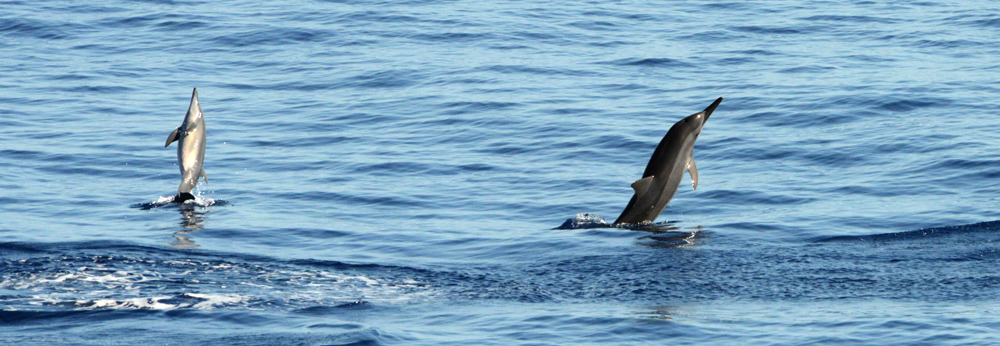
Dwarf spinner dolphins doing what they do best – characteristic longitudinal-axis spins!
Photo credit M. Jenner
While coming into the channel between North Reef and South Reef at Scott Reef last night, the moonlight illuminated the water in beautiful, gray tones. We listened with a sonobuoy and from the Portuguese bridge deck, I desperately looked and looked for whales, hoping to see one. My night watches have all been as lovely in the last week, with calm weather and an obliging, glorious moon. The moon throws a soft but strong lume across our entire vista.
We anchored in 45m of water on the south side of the channel and enjoyed a full night’s sleep! From 0630 we continued visual and listening observations for cetaceans moving within the channel, this is Day 1 of our survey here. A lovely breezy stream of coolness flowed over the top deck as we look and look, ever hopeful. Brown booby birds dive for small fish leaving deceiving splashes, huge waves break over an ever-growing patch of sand at East Hook and the tide changes bring patterns of distracting wind-lines and tidal races.
Around lunchtime, the blue sky and blue sea finally lured us in… As we slipped in, to cool off at mid-day, the water was simply gorgeous. The warmness enveloped you and brought you in. The blue takes over and you meld into the blue. I saw the anchor chain, as it goes straight down and the turn towards the anchor. We decided the visibility must be 30-35 m at least, since we have anchored in 45 m. Jellyfish, pink-toned, mid-sized medusa (13 cm across the umbrella) called Aurelia swam by, actively moving their circular muscles and two sea snakes surfaced near Whale Song. One, an olive sea snake and the other a Stokes sea snake, with a striking beige and brown striped pattern breathe and then dived vertically below lifting their paddle-shaped tails as they flopped over to descend straight down. The clearness of the water is beautiful, but it does alert us that perhaps there is low productivity and thus, we are uncertain if whale food is present. Comfortingly, we have already seen one blue whale near the Rowley Shoals, and are always hopeful for more.
At 1410 two spinner dolphins leapt and spun around characteristically. The animals located at 050 degrees are heading 320 degrees and are 1.5 nm away. A few minutes later we observed them approaching, this time continuously spinning at the surface! A close view of the spinning behaviour using my long lens from the top deck, revealed the dolphins’ pink belly – hinting at their scientific name. Dwarf spinner dolphins are indeed smaller than other spinner dolphins, but their Latin or scientific name is far more descriptive. Stenella longirostris roseventris perfectly describes this species, as it should. They are a spinner dolphin with the nomenclature Stenella, with a long-beak and a pink belly, being the direct translations for the second two attributed names. The pod of 50, in 2 groups, one with 20 animals (nearer us) and another association of 30 at 0.5nm just behind, are only vaguely interested in the boat, only approaching to 250 m away. Imagine seeing these dolphins in this clear water! Our imaginations run wild!
As the day progressed the soft tropical breeze fell and towards sunset the sea turned golden pink. A mere zephyr breeze accentuated slicks at the surface reflecting the molten gold of the setting sun. This is paradise, we can’t believe this place. Again, I fall deeply in love with Scott Reef. To me, this reef and the Kimberley are it, they write the book on spectacular scenery and beauty. Wow!
I prepared spaghetti bolognaise, or our “First Night-Out Pasta”, even though this is Day 20 and while stirring the pots we realised that the computer we have our hydrophone feeding to, is recording OUR sounds. We immediately enjoyed seeing the sounds, this is fun! THEN, we got an idea to write the word “whale” in sound. Maria recorded and Simon directed the show! Carrie did the W with a whistle, the H was my clap and a Carrie whistle and another clap by Curt, then Sam did the up tone whistling, Carrie the middle tone whistling and Sam the down sweep of the A, next I clapped for the L with a low whistle by Sam and then I whispered “Dolphin” for Skipper and he barked making the upright for the E with Inday, Carrie and Sam whistling for the horizontals. We paused in silence at the end and then absolutely roared with laughter! This is what people do without internet and face-book! Apparently! Normal for Curt and I to be missus TV and everything else for months at a time, but evidently a near “withdrawal” situation for others!
Getting acoustically creative at Scott Reef!
Mich
Day 21 Lovely Lagoons! (Written on Oct 18, 2013)
A delicious southerly breeze cooled the ‘I-am-going-to-be-hot’, feeling of the morning. Four to six knots of wind, slightly ruffled the water surface and cooled the constant “glow” on our brows. Cumulus clouds gather on the horizon, but only 1/8, or one oktas’ worth.
On the top deck or the fly bridge, while looking for whales, we seek shade and move from shady spot to shady spot, as it moves. We are in survival mode, albeit low level, regarding the warmness. Thus far the weather hasn’t actually been hot, compared with how it will be, in a month or two from November through until April – but for newbies to this climate, careful attention to ones wellbeing is required. The Kimberley is unforgiving, in many aspects. It demands your respect and undivided attention. For me, this is the supreme attraction. This place will chew you up and spit you out. You need to want to be here and you need to tread lightly.
The tools of our trade are binoculars and water bottles, both equally important. Sipping iced coffee or iced tea in flasks, we noticed a Brown Booby bird plummeting to the sea on a 45 degree angle, a noisy crested tern identified from well beyond the glare and a finely patterned bridled tern flitting by, pretending not to be interested in the boat. Hats, sunglasses, soft sun-shirts and shorts complete our research gear, with lashings of sun-block on any exposed skin.
With the midday sun, the puffy cumulus takes on a distinctive green hue. The clouds are heavenly reflections of the heavenly lagoons. We are surrounded by celestial green-ness, to the north and south. My shirt, flaps gently in the welcome breeze, bringing welcome relief. “Butterlies” – in the form of traditional, fishing vessels sail north in the lagoon, with these suitable airs. Moving from the southern part of South Reef, they slowly travel towards the middle of the western side.
Patience is a virtue, but also a life choice. The amount of time spent looking for cetaceans, greatly out-weighs the time spent with cetaceans. This is due to a multitude of reasons – none more evident, than the fact that only 10% of marine mammals’ lives are spent at the surface, where we are observing them. Once found, with visuals or acoustics, this just serves to increase the value of the sighting and the greatness of the experience of the encounter. One would think that after decades of observation, one might be cetacean-weary and lose interest. In fact, the thrill and excitement still remains, simply because of the importance of each sighting of different species at each location, due to persistent and potential threats to their ‘critical habitats’.
‘A chance of sunshine and fog’, should be our weather forecast! How is this possible during spring, in the tropics? As Carrie moved from the cool of the air-conditioning inside Whale Song to the fly bridge for her observation watch, “It’s foggy out!” she declares! Her glasses, cool from inside, immediately fog with the warm outside temperature. My binos and camera remain outside all day, in their protective pelican case, moved from one shady patch to another – ready for use and acclimatised. Otherwise, it takes a good 20 minutes for the condensation on the lens to clear and I don’t even want to know what could be happening to the electronics inside…
After two days of looking inside the channel, we will go adventuring tomorrow searching for krill (whale food) and survey for cetaceans in a few different locales. We shall see what is happening in this area. Some radio traffic and AIS signals indicate a seismic survey is operating nearby… will this be deterring/influencing the whales? There are always so many other situations that can be making a difference. Separating these becomes part of the art of science.
With a golden orange sunset and the full moon rise over a pink sea,
Mich
Day 22 Is the Whale Cafe Open? (Written on Oct 19, 2013)
When I raised my head to look out our window, I could not believe my eyes… the sea was golden without a ripple, the sky was golden and the sun was just above the horizon… but where is that? The interface between sea and sky – is barely perceptible.
“Look Curt, you have to see this… I coax him to sit up, to check out our day ahead. “Oh, that’s alright!” he managed and then slipped down again, “Ok, it is time to get up, right now”.
With my camera, I padded quietly around the decks, to get photos – in Panorama-mode, especially! My Coolpix struggled and mostly won’t do the Panorama 180 degree thing. Consulting the manual, I realised it is because the camera simply can’t focus – THE DAY IS TOO SPECTACULAR FOR THE CAMERA TO FOCUS! Yes, I LOVE this world!
At 0700 we lifted the anchor and imperceptibly glided on a ‘magic, carpet boat ride’. This is one of our favourite types of days. In the glassy, calm water flying fish skip into the air, waving their tails from side to side in around 20-30 zig-zags to become airborne. The zig-zags then become circles, as the pattern loses its’ energy and returns to flat again.
Deploying the echo-sounder we could see a large concentration of krill in the centre of the eastern part of the channel. The cafe is open, we are encouraged by this! Whale food is present here, but, is it enough? In the blue, an Aurelia, a mid-sized pink jellyfish, slowly makes its’ way in life with gentle umbrella movements. A turtle popped its’ head out to breath at the surface. Every ten minutes or so, we saw another piece of rubbish float by. Clear plastic sheeting tinged with barnacles and algae (perhaps water-born for a while) and torn Asian food wrappers, are the most commonly seen.
From 0700 until 1500, we travelled towards the east of the channel, then zig-zagged through 10 transects across the 300-400m deep channel, progressively moving slowly westward. At 1500, on the west side and just outside the reef, we deployed a sonobuoy to monitor whale calls and as well, the ship-mounted hydrophone – for comparison of detections. Drifting in the glassy water, we continued looking and looking.
For lunch we had salmon wraps with lettuce and other fixings including salami/cheese – which went down well with our hungry crew. I cover Sam’s back and provide the only fish of the trip thus far with random lunches of Canadian canned salmon… one day we’ll catch a fish… says he, longing at the edge of the plate!
One to two knots ruffled the surface, giving it a dark tone, the first hint of colour on the water rather than the all “white sea” and all “white sky”. Then at 1300, thirteen cumulus clouds formed above the lagoon of North Reef in the hour from midday, when the weather reading had no clouds at all. These clouds are turning green with the strong, high noon sun.
We anchored at the end of the day, under a large, but-one-day-old, full moon casting beautiful light on the water. Dinner at 7pm of roast chicken, mashed potato, rice and salad is consumed after exercise sessions by the crew. Delicious! What will tomorrow hold?
Under a bright moon we wait for a blue whale to swim by…,
Mich
Day 23 Another Day in Paradise! (Written on Oct 20, 2013)
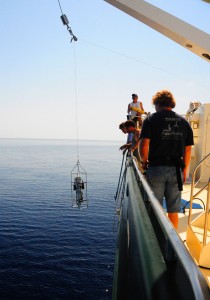
Deploying the CTD unit the crew guestimates the bottom sea temperature reading!
Photo credit M. Jenner
The day began in the same magnificent way as yesterday – a full scale glass off! We continued survey with the Bio Sonics in a similar area to yesterday and then made our way out of the channel and southwards down the outside of South Reef. At 0924 we deployed the CTD unit to collect information on Conductivity (salinity), Temperature and Depth in 400 m of water. All the crew put forward their guesses for the temperature reading at the bottom. Let’s see, it is spring, we are in the tropics but it is going down deep… I made the first guess of 8.20 C, Curt guessed 6.8 and then everyone took a position somewhere in between our guestimations! Once downloaded, Curt announced that the water temperature at the bottom is 8.80 C! I get – I don’t know what for guessing closest!
At high tide, the water is smooth and the lagoon radiates a simply wonderful florescent, light green. This bright colour is the clear, shallow water overtop sand. Patches of small, beige-toned coral bommies scattered throughout the lagoon, add turquoise hues to the glowing green. A brown smudge, at the edge of the green and turquoise ‘water-colours’, is the colour of the living coral atoll, rising from 400m towards the surface. Beyond the line of brown reef, pockets of bright turquoise and electric blue are deeper sand holes and channels or ‘cracks’ in the atoll reef, running perpendicular to circular atoll. These colours are simply gorgeous. When I get stuck in the turquoise part of my wardrobe, (quite often I am afraid!), it is because we experience these colours in nature in their most intense and alluring hues. I like to remember the reef and the lagoons with these colours. The blue palate is the sea and being a Piscean, here I am! Internal waves or slicks, presenting at the sea surface as glassy calm lines, are laden with orangey algal ‘spooge’ and flotsam and jetsam. The scene is framed with a deep, dark blue line on the horizon. This is the deep water of the lagoon, being 40-50 m deep in South Reef. And we aren’t even see the other side of the lagoon! I LOVE this place so much. I can’t even verbalise it, for a change!
The ancientness of this reef structure is mind-boggling and the importance of these coral reef communities within this tropical ecosystem, unparalleled. As we travelled south-east along the edge of the reef, again we are enticed INTO the water. Sam drove Orca, Simon filmed with his GoPro attached to his mask using his home-made manta board and I was the spotter for Simon. The view was magnificent – the edge of the coral atoll in a curving shape of divine lumpiness beautifully arrayed with a myriad of corals adorning every surface. We decided the vis (water visibility) is 20-30 m. After a while, I couldn’t resist and popped my head into the water to watch Simon from below. My view of the world was curiously upside down! The water was below me, the fish swimming mid-water and the coral bommies are situated above my head! This whole thing feels weirdly Alice-in-Wonderland-ish! All manner of circular corals crammed the entire space of the reef, making the reef. They are perfectly and equally positioned beside each other, filling my vision with live-ness. Clouds of hundreds of surgeon fish swam along ridges of coral, bordering a patch of sand, carefully made by parrotfish eating the algae on the coral and pooping out the extra coral! A huge school of my favourites, neon damsels flitted above the coral in slow motion. Below me, a green turtle flapped its’ way along the sand patches and near the coral florets. Ten metres away, another turtle is looking for jellyfish. This part of the reef appears healthy – there is new growth everywhere, which is encouraging and at once delightful!
Simon got great manta board footage and then I had a quick go – this was simply fantastic! Tilting the board up or down – you go up or down! The view insane and the ride wonderful! I am in watery heaven! After Sam, Simon and I returned to Whale Song in Orca, the remainder of the crew piled in for a snorkel at the reef edge. Sam drove Curt, Resty, Inday, Maria and Carrie, while Simon and I watched from Whale Song, able to identify individuals as they dive with their flippers flaying vertically and on various angles! With all crew back on board and off “snorkel watch” I quickly made lunch for the hungry gang. Heating mashed potato, pork mince with veggies, salami and cold chicken with baguettes and salad, consuming lunch underway, as usual. Back on the move, I took my regular 12-3 watch beginning with my noon weather observation, driving Whale Song around the outside edge of South Reef, towing the sounder for the krill. From East Hoek to the southern tip of South Reef our route is 0.4 nm from the ring of the coral atoll, determining krill biomass. The coolest thing is that we are less than half a mile from the reef and the water is 400m deep! We do a second CTD station and again my guess of 9.1 is the closest to the real temp of 9.3! Yahoo!
On the west side at 1700, great yelling and excitement on the stern heralded a fish that tried to get away… how dare it! Resty and Sam valiantly saved the almost-fleeing beast and soon enough, it is thoroughly succumbed and filleted for dinner. The planned bbq shish-kebabs are shelved for tomorrow, although we do try a few tasters! The main feature of the meal is now pan-fried fish, expertly complimented by fried rice and salad. This dinner is a perfect end, to another perfect day!
Dinner dishes are done with the dulcet tones of Paolo Nutini while watching Simons’ GoPro footage. Curt checked my D800 topside video, which also looks great. Inday also collected great u/w video. Collectively, we will all dream of the reef tonight. I am always impressed by the sense of community a reef imbues.
With lovely reef-ness,
Mich
Day 24 Mola mola Moments… (Written on Oct 21, 2103)
P for paradise, again… Three knots, instead of zero knots lightly ruffled the water surface this morning. After breakfast, we raised the anchor at 0700 and made our way to three way-points bordering the south edge of North Reef and across the channel. To determine movement and thus possible differences in density of the krill throughout the day and namely the tide, we plan a day of Bio Sonics and CTD drops. To cover a full tidal cycle of 12 hours, while driving we are drawing green-lined triangles on the nav chart, with our passage, between these three way-points. At 0740 we commenced, and proceeded for the whole day in an anti-clockwise direction. Each time as we approached the edge of the reef, the colours are sooo beautiful. My four toned, green and turquoise striped beach towel almost captures it, in a non-random fashion.
With shade a premium, I go aloft on the radar towers, desperately wanting to find a whale… From the second platform the view is extensive and I am ever-hopeful. A slightly strange splashing and my report “I can see the sun glinting on the dorsal” is more correct, than I realise at the time. The bearing is 300 degrees and 0.7 miles, Curt ship turned and we headed that way. The movement of “tips” at the surface, perhaps of a manta ray, is deceiving. A largish, white body and the flailing tips, sort of seems like a manta ray, but why is the belly upwards? Is it feeding? As we got closer, we saw the blobby body of a Mola mola or sunfish! The unusual movement is due to hindered control of its’ fins. As we drifted nearer we realised that it was still alive, although missing it’s ventral fin, the tail and another chunk from the body. These are shark bites, the poor thing. The flailing “tip” is the dorsal fin of the Mola mola, almost 1.25 m long, making a figure-of-eight pattern just below the surface. The whiteness and brownness seen, is the ventral area and dorsal portion of the fish floating at the surface. The other movement, causing swirling white-water, is the desperate flapping of the fan-shaped, pectoral fin. Sunfish are an unusually shaped fish. They possess long, almost triangular-shaped dorsal and ventral fins, brown-toned and with distinctively, wide-rounded tips. With the ventral fin missing, this fish was only able to float, though desperately trying extremely hard to manoeuvre in its’ normal manner. Once we realised this, we knew we were witnessing the cruel cycle of life, and death in the ocean.
Beside the flailing Mola mola, tragically, we could see a lurking shape. “There’s a shark, as well!” Inday called out. Suddenly, the troops grabbed all their cameras – “Sam Cam” (a GoPro on a pole), Indays’ film camera shot by Maria, Indays’ Sony on a pole and with my two Nikons clicking away, we are certainly going to capture this event. Sure enough, as we watched closely, the animal swam in the calm water near the boat and we could see the colouration pattern of a white belly and blue-grey body and the blunt head (seen from above), leading us to the conclusion that this was a good sized tiger shark! Wow, from the passes swimming by, we estimated the shark to be between 2.5 and 3.0 m long. Sams’ footage showed the shark lurking beneath the sunfish. As the sunfish continued to try to right itself and attempted to make its’ great escape, the dorsal and pectoral fins are moving constantly, the mouth was open and with the lens captured the fear, or perhaps near-death-ness in the eye. A deep blue of the iris, shows in the photos. What a rare occasion, to gaze into the eye of a sunfish. Several hundred photos later and several minutes of video later, we leave the sunfish to proceed to our CTD drop point (the same place all day).
After lunch of heated fried rice, lettuce and salady things (corn, carrots, celery and cheese) we continued CTD drops. At 330pm we had a second sighting of the Mola mola. This time there is less of the fish left, but sadly the gills were still moving – it was still alive… For 20 minutes we followed and then proceed to the second last CTD station. Several hundred photos later, we have documented the demise of a beautiful animal by another beautiful creature.
At sunset or close to, we did the last CTD station of the day and then anchored at 1815 pm. Dinner was yummy, as always, oven-baked fish, steamed rice, beef and pork kebabs and lettuce salad. Delicious and oh-so healthy too!
At 8pm we began planning a listening night. We will all sleep lightly as Inday, Maria and Carrie will monitor the ship-mounted hydrophone for blue whales. If and when we hear one, we will go looking, using the night vision camera. Wow, here’s to looking all the time!
Mich

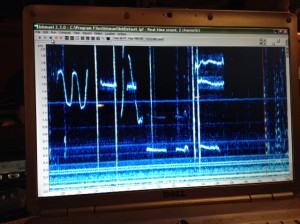
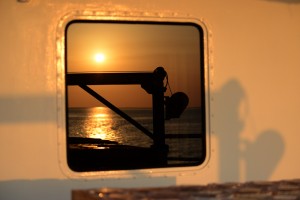
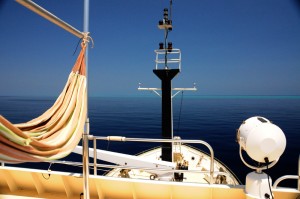
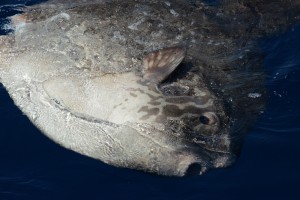
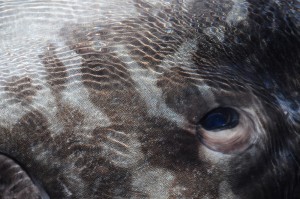



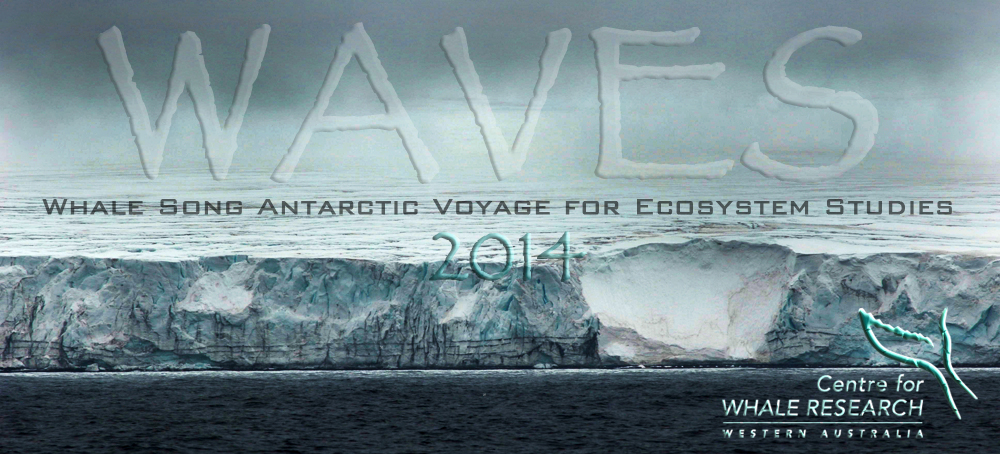










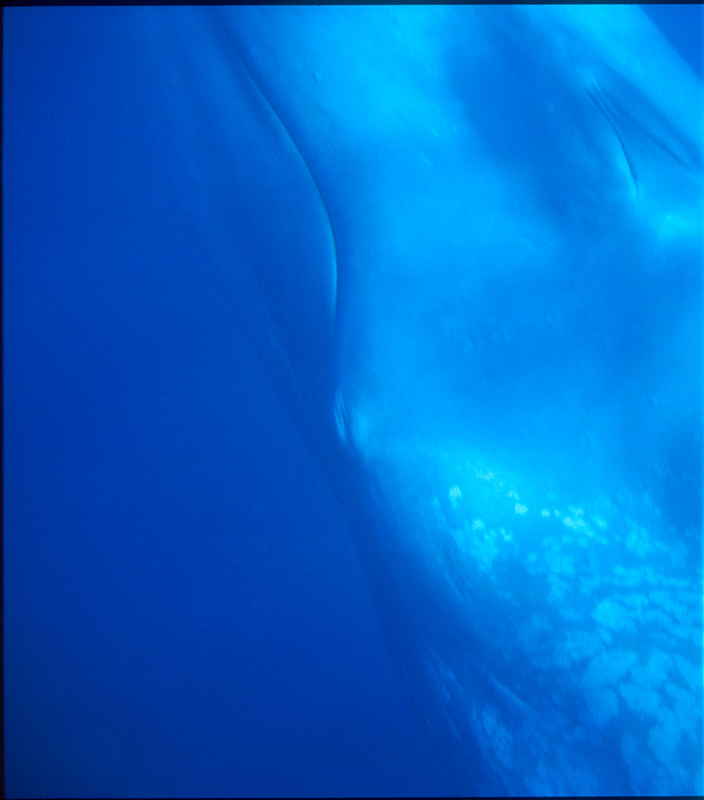
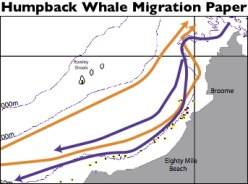
No comments yet.